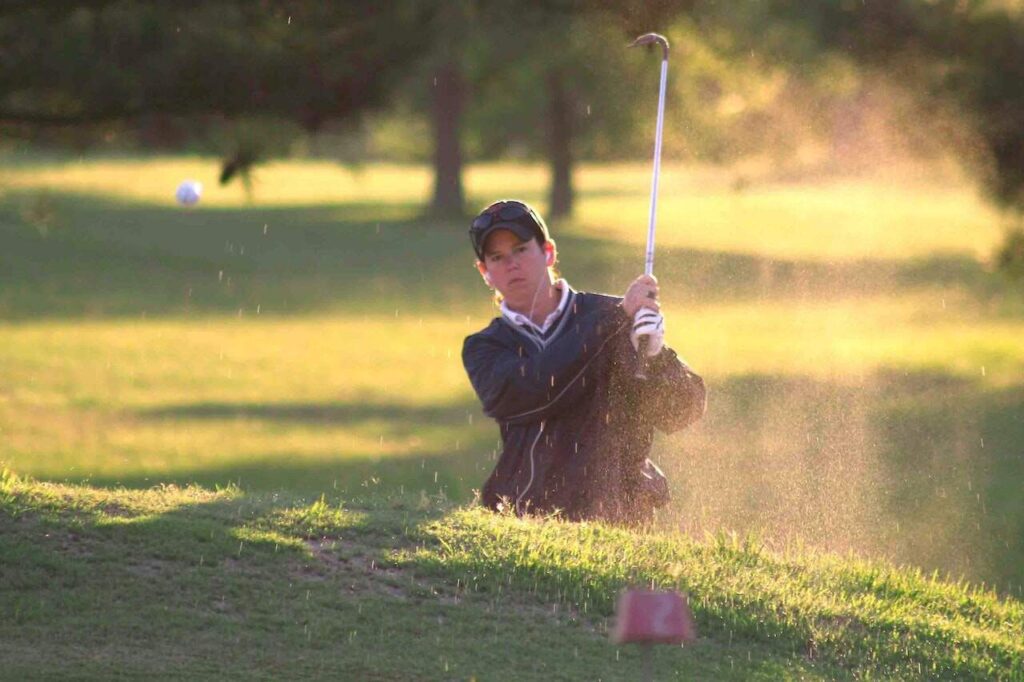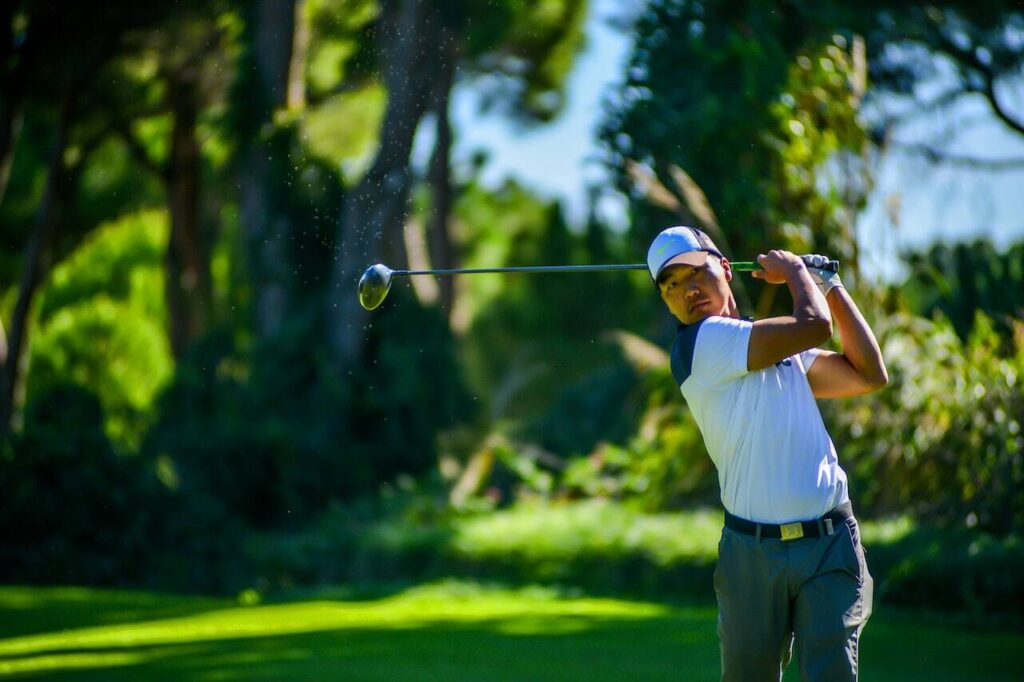To really start flushing your irons, you need to get three things right before you even think about swinging the club. I’m talking about your grip, your stance, and where you place the ball. When you lock in this pre-shot setup, you give yourself the best possible chance to strike the ball first and then the turf—that’s the secret sauce for pure, compressed iron shots. This foundation is what separates inconsistent ball striking from reliable, solid contact.
Understanding how to hit irons purely and consistently is essential for every golfer. It’s crucial to focus on how to hit irons during your practice routines.
Learning how to hit irons is a crucial skill that every golfer should master. Success in golf often hinges on mastering how to hit irons correctly.
Practicing how to hit irons can lead to significant improvements in performance and will unlock your potential. With commitment, you will see progress in how to hit irons over time.
Building Your Foundation for Pure Iron Strikes in Golf
Understanding how to hit irons can help you navigate tricky situations on the course. With time and dedication, you’ll master how to hit irons perfectly.
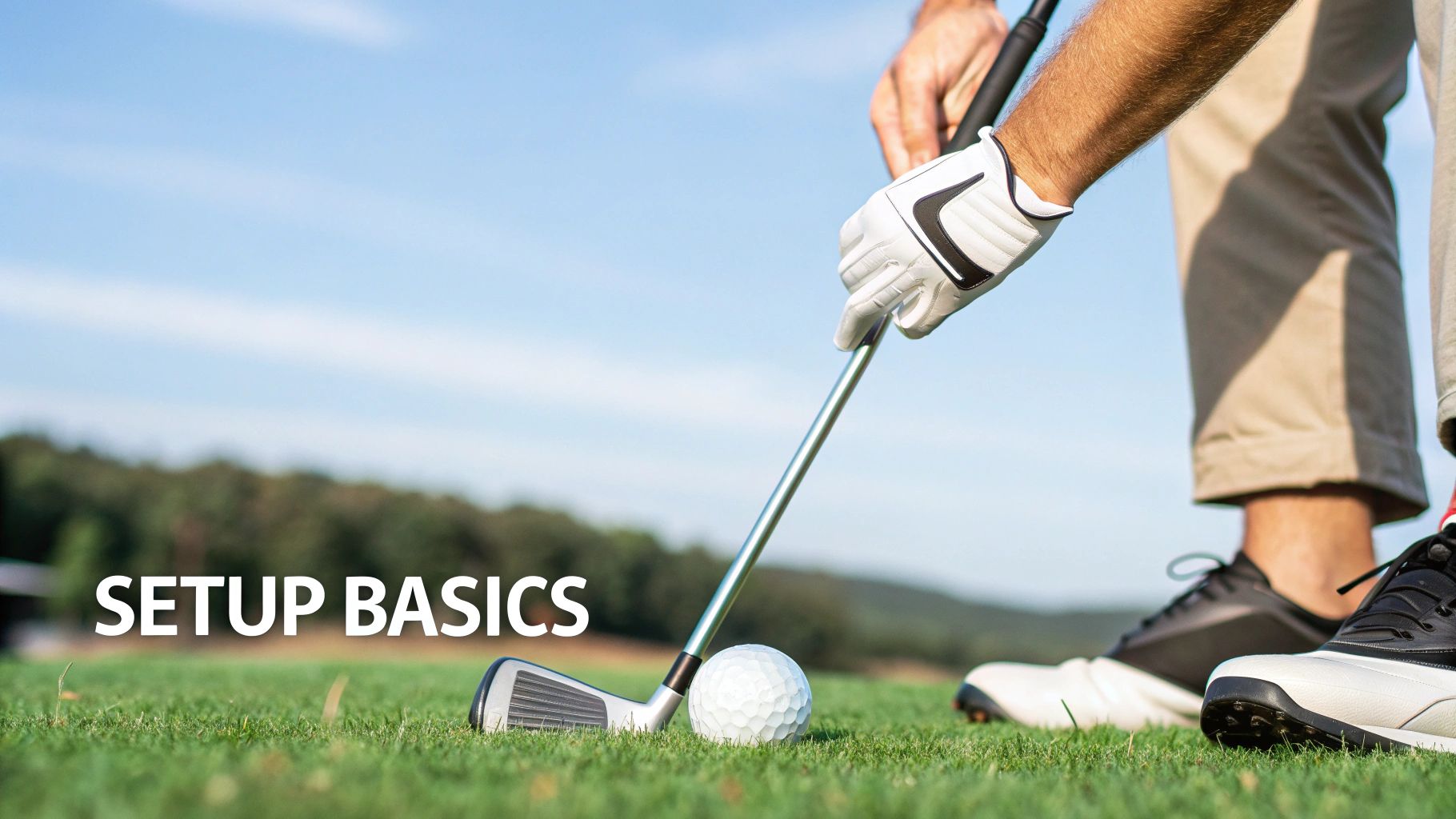
To truly understand how to hit irons effectively, remember the importance of your setup. So many golfers get lost chasing complex swing thoughts, hoping to find that one magic move. But the real secret to crisp, consistent iron play is usually found in the simple things you do before the club even moves. Think of it like building a house—a shaky foundation means the whole thing is coming down. Refining your approach is key when learning how to hit irons. Becoming proficient at how to hit irons is a journey worth taking.
Remember to incorporate how to hit irons into your training regime. In golf, that foundation comes down to three non-negotiables that work together to create a swing you can repeat under pressure:
- Your Grip: This is your only connection to the club. A good grip is all about clubface control, which directly influences your shot’s direction and power.
- Your Stance: This is your base of operations. The right stance provides the stability you need for a balanced, athletic turn.
- Your Ball Position: This little detail dictates the low point of your swing. Get it right, and you’ll make that pure, ball-first contact every time.
Nail these three, and you make it a thousand times easier to deliver the club back to the ball on the right path and with the proper angle of attack.
Mastering the Neutral Grip in Golf
Your hands tell the clubface where to point at impact. A neutral grip is your first line of defense against the hooks and slices that drive most amateurs crazy.
Here’s a simple way to find it: let your lead arm (left for right-handers) hang naturally by your side. See how your palm isn’t facing straight ahead or straight back? It’s slightly turned inward. That’s the position you want to replicate on the club.
When you place that lead hand on the grip, you should be able to see about two knuckles. Then, your trail hand should fit snugly right beside it, with the lifeline in your palm covering the thumb of your lead hand. Understanding how to hit irons is vital for all golfers aiming to improve. Getting this right is a game-changer, and we dive deeper into it in our guide on the importance of a proper golf grip.
The Right Stance for Every Golf Iron
Your stance width needs to adapt to the club in your hand. For your short irons—think 9-iron or wedges—your feet should be about shoulder-width apart. This gives you a stable but compact base for a very controlled swing. Pay attention to how to hit irons during practice to see improvement.
As you grab your mid-irons (like a 7-iron) and especially your long irons (a 4-iron, for example), your stance should gradually get a bit wider. This broader base provides more stability to support the longer, more powerful swing these clubs demand.
A huge mistake I see all the time is players using the same super-wide stance for every club. That makes it incredibly tough to control your shorter irons and often leads to a loss of balance and topped or thin shots.
The Truth About Golf Ball Position
Ball position might be the most misunderstood fundamental in golf. It’s not complicated, but it is specific.
For your shortest irons (8-iron, 9-iron, wedges), the ball should be dead in the center of your stance. This helps you create a steeper angle of attack, which is exactly what you need to hit down on the ball and create spin.
With mid-irons (5, 6, 7-iron), move the ball just slightly forward of center—about one or two golf balls’ width toward your lead foot. For long irons and hybrids, it creeps another ball’s width forward. This subtle shift accounts for the slightly different swing arc with each club, making sure you catch the ball at the perfect spot.
To put this into perspective, remember that precision is everything with irons. On average, amateur golfers only hit the green with a 7-iron about 19% of the time. Those numbers prove just how much small setup errors can impact your results, making a consistent foundation absolutely essential.
Golf Iron Setup Checklist At-a-Glance
Feeling overwhelmed? Don’t be. Here’s a quick cheat sheet to help you dial in your setup for every iron in the bag. Keep this table in mind next time you’re on the range.
| Iron Type | Stance Width | Ball Position | Shaft Lean |
|---|---|---|---|
| Short Irons (8, 9, PW) | Shoulder-width | Center | Slight forward lean |
| Mid Irons (5, 6, 7) | Slightly wider than shoulders | 1-2 balls forward of center | Slight forward lean |
| Long Irons (3, 4) | Wider than shoulders | 2-3 balls forward of center | Minimal (hands even with ball) |
Referring to a simple checklist like this can build fantastic habits and take the guesswork out of your pre-shot routine. It ensures you’re giving yourself the best chance for success before you even start the swing.
The Secret to That “Crisp” Iron Shot in Golf
Let’s get one thing straight right off the bat, because it’s a myth that absolutely kills amateur iron play. Most golfers believe they need to help the ball get into the air. They try to “sweep” it or, even worse, “scoop” it. This one single thought is the reason you hit those frustrating thin shots that scream across the green or chunky fat shots that dig a trench behind the ball.
The real secret to that pure, compressed sound you hear from the pros? It’s doing the exact opposite.
To hit your irons flush, you absolutely must hit down on the ball. I know it feels counterintuitive. It sounds like you’d just drive it into the ground. But the club’s loft is designed to do the work of getting the ball airborne—your only job is to deliver a descending blow. When it’s done right, the sequence is non-negotiable: ball first, then turf. That perfect, bacon-strip divot? It always starts just in front of where your ball was.
The Downward Strike Is All About Weight Shift in Golf
Now, hitting “down” doesn’t mean you should get super steep or chop at the ball like you’re cutting wood. That’s a whole other problem. A proper downward strike is simply the natural result of a correct weight transfer into your lead side. The feeling you’re chasing is a distinct pressure shift onto your lead foot before the club ever gets to the ball.
Think of it like this: as you transition from the top of your backswing, your very first move should be feeling that pressure build under your lead foot (your left foot, for a righty). This simple move anchors your lower body, stops you from swaying, and drops the club right into the perfect slot to strike down and through the impact zone.
“A great iron shot feels less like a hit and more like a squeeze. You’re compressing the ball against the clubface, and that only happens when your weight is forward at impact, allowing the club to descend.”
How to Actually Feel the Right Impact Position in Golf
Let’s try a quick drill without a club. Get into your setup, make a backswing motion with your arms, and as you start your “downswing,” just take a small step with your lead foot toward the target as you turn your hips. Feel how your weight just naturally plants itself on that front side? That’s the sensation you’re after.
So many amateur players get stuck on their back foot, hanging back and trying to lift the ball. This makes the bottom of their swing arc happen behind the ball, which is a recipe for weak, inconsistent contact.
Instead, here are the key checkpoints you should be looking for at the moment of truth:
- Your hands should be slightly ahead of the clubhead at impact. This is called forward shaft lean, and it’s what creates that powerful compression.
- Your hips should be more open to the target than your shoulders are. This is proof that your lower body is leading the charge.
- The vast majority of your weight—we’re talking 70-80%—needs to be firmly planted on that lead foot.
By making “get my weight forward” your main thought, you create the perfect conditions for the club to do its job. You finally stop helping the ball and start trusting the physics of a descending blow. That, right there, is the key to unlocking pure, powerful iron shots.
Your Simple Sequence for a Repeatable Iron Swing in Golf
The key to success is practicing how to hit irons with intention. A great golf swing isn’t a jumble of random parts moving at once; it’s a fluid, connected motion where everything syncs up perfectly. I see so many golfers get bogged down trying to perfect a dozen different positions, and honestly, it’s a recipe for disaster. Let’s ditch that mindset.
Memorizing the principles of how to hit irons will help in the long run. We’re going to simplify the entire motion into a logical, athletic sequence you can actually feel and, more importantly, repeat on the course. The goal isn’t to look like a tour pro on TV, but to build a swing that’s reliable for your game. By focusing on how the takeaway flows into the backswing and finishes with a committed follow-through, you’ll stop thinking mechanically and start swinging like an athlete.
Starting with a One-Piece Takeaway
The first two feet of your swing set the tone for everything else. A classic mistake I see all the time is players snatching the club away with just their hands and arms. This immediately throws the club off plane and disconnects it from the body’s rotation, forcing you to make all sorts of complicated saves later on.
The fix? It’s all about the “one-piece takeaway.” This just means your hands, arms, and chest all start moving back together as a single unit. Picture that triangle your shoulders and arms form at address—your only job is to maintain that shape as you begin the swing.
A simple thought I give my students is to feel your lead shoulder (left shoulder for a righty) initiating the movement. When you do this, your arms and the club will naturally come along for the ride, keeping everything perfectly in sync from the get-go.
This connected start guarantees your club stays on a good path and primes you for a powerful, efficient turn.
Many resources can assist you in learning how to hit irons with precision.
This simple infographic below is a great visual for the essential sequence at impact, which is a direct result of a well-sequenced swing from the start.
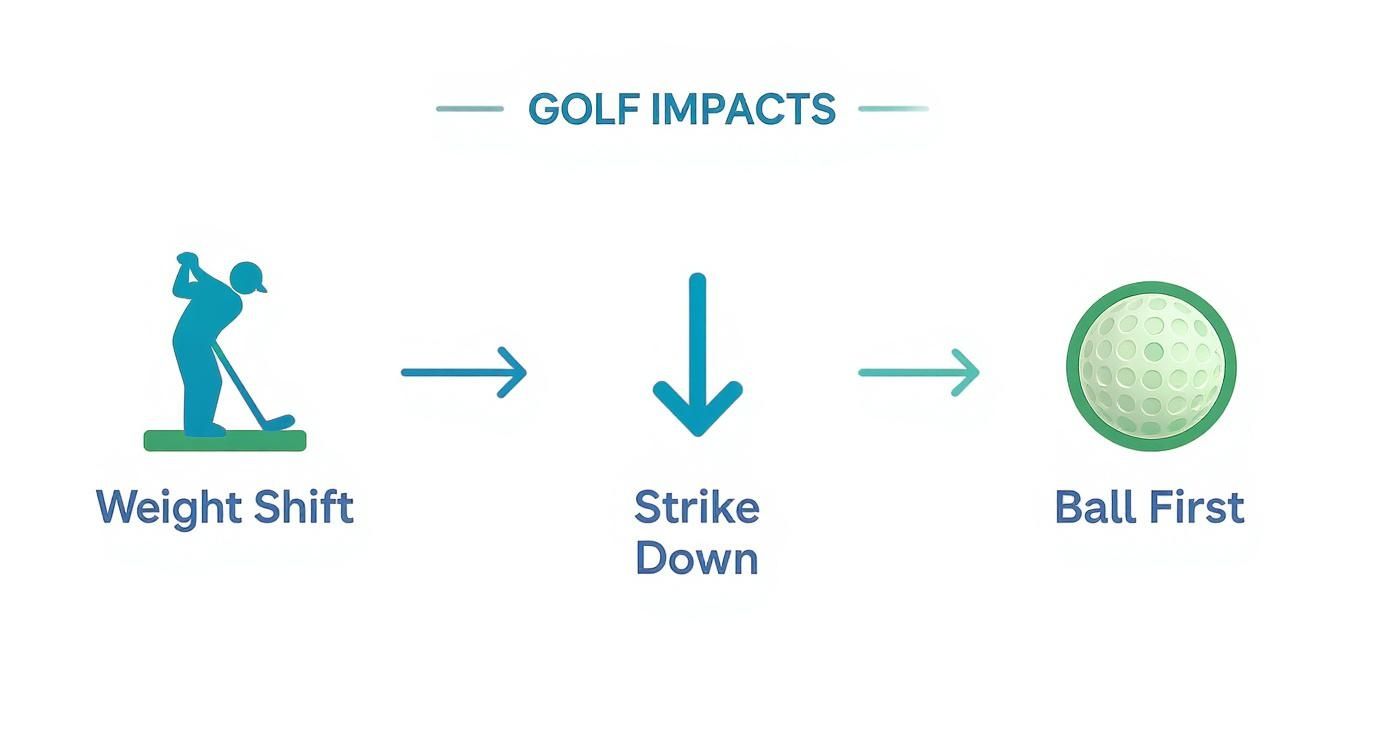
This process really highlights how a proper weight shift allows you to strike down on the ball first, creating that pure, compressed contact all great iron players achieve. Your journey in golf can greatly improve once you learn how to hit irons.
Golf: Turning Against a Stable Lower Body
Once the club is away, the backswing continues by turning your upper body. The engine of your swing isn’t your arms—it’s the rotation of your torso. You want to feel like you’re coiling your upper body against a stable, resistant lower body. Think of it like winding up a spring to store a ton of energy.
To get this feeling, focus on making a full shoulder turn, getting your back to face the target as much as your flexibility allows. At the same time, your lower body should stay relatively quiet. You don’t want to lock your knees, but you absolutely have to prevent your hips from swaying away from the target. This separation between your turning shoulders and stable hips is what creates that powerful torque you’re after.
Golf: Finishing with a Committed Follow-Through
Your swing doesn’t just stop when you hit the ball. A full, balanced follow-through is the ultimate sign that you’ve transferred all that stored energy correctly and stayed in balance. So many high-handicappers quit on the shot right after impact, which leads to weak, thin shots and a major loss of power.
Here’s a great checkpoint: finish with your chest and belt buckle pointing directly at the target. Your weight should be almost entirely on your lead foot, with your trail foot up on its toe just for balance. If you can hold this finish for a few seconds, it proves you stayed in control through the entire motion. Don’t be afraid to really “let it go” and swing through to a complete, statuesque finish. With practice and knowledge on how to hit irons, you can become a more consistent player.
We’ve all been there—standing over a shot and having no idea why the ball isn’t going where we want it to. Most of the time, it comes down to a few common faults that are surprisingly easy to spot if you know what to look for.
Here’s a quick troubleshooting guide I put together to help you self-diagnose and get back on track.
Common Golf Iron Shot Problems and How to Fix Them
| Common Swing Fault | What It Looks Like | How to Fix It |
|---|---|---|
| Swaying | Your hips and body move horizontally away from the target during the backswing, instead of rotating. | Place a golf bag or alignment stick just outside your trail foot. Focus on rotating around your trail leg without bumping into the object. Feel like you are loading into your trail hip, not sliding past it. |
| Casting (Early Release) | You unhinge your wrists too early in the downswing, losing power and clubhead speed. The clubhead “throws” from the top. | Try the “Pump Drill.” Make a backswing, start down until your hands are waist-high, then go back to the top. Do this 2-3 times before swinging through. This teaches you to retain the wrist angle (lag) for longer. |
| Chicken Wing | Your lead arm (left for righties) bends and separates from your chest immediately after impact, looking like a chicken wing. | Place a headcover or towel under your lead armpit. Make swings trying to keep it there through impact. This forces your body to rotate and keeps your arm connected, preventing the bend. |
| Standing Up (Early Extension) | You lose your spine angle and posture through impact, causing your hips to move towards the ball. This often leads to thin shots or blocks. | The “Chair Drill” is perfect for this. Set up with your rear end just touching a chair or golf bag. As you swing, focus on keeping contact with the object all the way through impact. This forces you to maintain your posture. |
Remember, identifying the problem is half the battle. Use these checkpoints the next time you’re on the range, and you’ll be amazed at how quickly you can correct these common issues and start hitting purer iron shots. Studying how to hit irons can greatly enhance your understanding of the game.
Golf Drills That Actually Build Muscle Memory
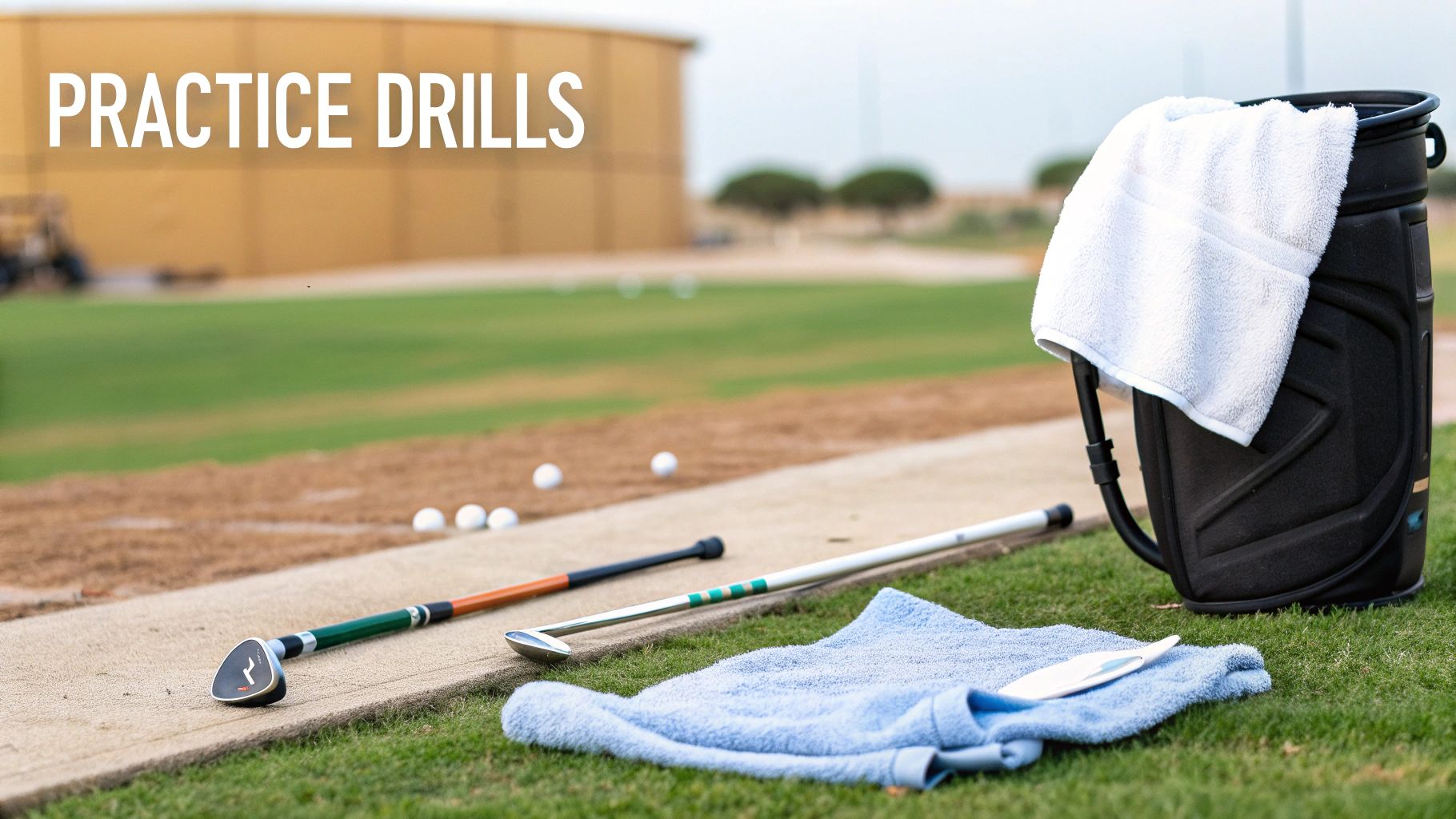
Practicing how to hit irons can lead to great progress in your game. Knowing what a great iron swing should look like is one thing. Getting your body to actually do it is another story entirely. Real, lasting change in your golf swing comes from repetition—ingraining the correct feelings until they become automatic.
That’s what drills are for. They’re not about mindlessly beating balls. They’re about targeted practice that translates swing thoughts into real muscle memory, giving you specific feedback to build a reliable, repeatable motion.
The Golf Towel Drill for Connection
One of the biggest swing killers in golf is coming “over the top.” This is where the arms get disconnected from the body’s rotation on the downswing, leading to that dreaded steep, outside-in path that produces weak slices and pulled shots. It’s a frustrating cycle.
The fix is surprisingly simple. Just tuck a small towel under your lead armpit (that’s your left for a right-handed player). The only goal is to make practice swings—and eventually, little half-shots—without letting that towel fall out.
This simple little trick forces your lead arm to stay connected to your chest. You’ll immediately feel how your body rotation starts powering the swing, not just your arms. It’s the best drill out there for syncing up your sequence and promoting a powerful, inside-out swing path.
The Golf Impact Bag Drill for Solid Contact
Ever feel like you’re “scooping” the ball or catching it thin? That’s almost always a sign of your hands flipping at impact instead of leading the clubhead through the ball. The impact bag is the perfect tool to cure this because it gives you instant, undeniable feedback.
Set the bag up right where you’d normally place your ball. Take some slow, controlled swings with the single focus of striking the bag as your body rotates through the shot.
You’re aiming to feel your hands well ahead of the clubhead at the moment of impact. You’ll know you’ve nailed it when you hear a solid thump and the bag absorbs the energy without your wrists breaking down. This drill is all about ingraining the feeling of forward shaft lean—the secret sauce for compressing the golf ball like a pro.
The impact bag doesn’t lie. If you flip your hands, you’ll deliver a weak, slapping strike. But when you lead with your body and keep your hands ahead, you’ll feel the powerful, stable impact position of a great ball striker.
The Golf Alignment Stick Gate Drill for a Better Path
The slice. The most common miss in golf, and it’s usually caused by that outside-to-in swing path we talked about. The “Gate Drill” is a fantastic visual aid for retraining your swing to approach the ball from the inside, which is what you need to hit a powerful draw.
Here’s how to set it up:
- Stick one alignment rod in the ground a few feet behind the ball, just to the outside of your swing path.
- Place a second rod a few feet in front of the ball, but just to the inside of your target line.
These two sticks create a “gate” your clubhead has to swing through. If you come over the top, you’ll clobber the outside stick on your way down. Swing too much from the inside and you’ll hit the other one on your follow-through. Looking for more ways to use these simple training aids? Check out these other highly effective golf alignment stick drills that can fix a number of swing flaws.
When you can swing through the gate cleanly, you are physically training your club to travel on the correct, shallow path. Make this drill a regular part of your practice, and you can virtually eliminate that slice for good.
Knowing Your Distances for Smarter Club Selection in Golf
There’s nothing like the feeling of catching an iron shot perfectly pure. It’s a sweet, compressed sensation that keeps us all coming back. But that feeling is only half the battle. The part of the game that actually carves strokes off your handicap is knowing exactly how far that perfectly struck ball is going to fly.
It’s all about turning guesswork into genuine confidence.
When you’re standing in the fairway looking at a 150-yard shot to the green, you need to know which club is the right tool for the job. You can’t just go off the memory of that one time you absolutely nuked a 7-iron and it flew 170 yards. Smart course management is built on your average carry distance—the number you can count on time and time again.
Frankly, this knowledge is what separates good ball-strikers from good players. It dictates every decision you make on the course and is the fastest way to start hitting more greens in regulation. Developing a strong understanding of how to hit irons can change your game.
Gapping Your Golf Iron Set
The process of dialing in your true yardages is called gapping. The idea is to figure out the consistent distance gap between each of your irons. In a perfect world, you’re looking for a predictable jump—usually 10-15 yards—as you move from a 9-iron to an 8-iron, an 8-iron to a 7-iron, and so on.
The best way to do this is to head to a driving range, ideally one with good yardage markers or, even better, a launch monitor. Your mission is simple: hit about 10 solid shots with each iron, from your pitching wedge all the way up.
- First, toss out any obvious mishits. We’re not measuring your chunks or thin shots.
- Next, ignore that one miraculous shot that flew way past the others. That’s an outlier, not your standard.
- Focus on where the majority of your well-struck shots landed. That cluster is your real-world carry distance for that club.
Knowing your stock yardages builds a foundation of trust in your swing. When you’re standing over a critical approach shot, that trust is everything. It frees you up to make a confident, athletic move instead of a tentative, steering motion.
Understanding your personal numbers provides some crucial context. While PGA Tour pros average around 218 yards of carry with a 3-iron, the average weekend golfer’s stats are going to look a lot different. That’s why you can’t base your club selection on what you see on TV. For a little perspective, you can see how the pros stack up by checking out these PGA Tour club averages from Golf Monthly.
Adjusting for Real-World Golf Conditions
Once you’ve established your baseline distances on the range, the real art begins: learning to adjust them on the fly. Your 150-yard 7-iron doesn’t always fly 150 yards out on the course. A whole host of factors can—and will—change that number. Understanding how to hit irons can lead to better course management.
You’ll need to learn to play weatherman and surveyor, considering these common variables:
- Wind: A headwind can easily shave 10-20 yards off a shot, forcing you to “club up.” On the flip side, a tailwind can give you a huge boost, meaning you’ll need to take less club.
- Elevation: Hitting uphill? That shot is going to play longer, so you’ll need more club. Hitting down into a valley? It’s going to play shorter. A decent rule of thumb is to adjust one club for every 15 feet of elevation change.
- Lie: Is the ball sitting up fluffy in the rough? Be ready for a “flyer lie,” which reduces spin and can send the ball sailing 10-15 yards farther than you expect. If it’s nestled down in a divot or thick cabbage, it’s going to come out much slower and shorter.
Learning to hit your irons well is a blend of solid mechanics and smart on-course strategy. Mastering your distances is a massive piece of that puzzle. Reflecting on your progress will reinforce how to hit irons for better results. Developing a strong understanding of how to hit irons can change your game.
FAQ’s
Even when you feel like you’ve got the fundamentals down, there are always a few nagging questions that pop up on the journey to becoming a great ball striker. Let’s tackle some of the most common ones I hear from golfers trying to really dial in their iron play. As you improve at how to hit irons, your confidence will follow. Pay attention to how to hit irons during practice to see improvement. Think of these as your on-course troubleshooting guide.
Why Do All My Irons Go the Same Distance?
I see this one all the time. It’s a classic symptom of “casting” the club, which is just a fancy way of saying you’re unhinging your wrists way too early in the downswing. When you cast, you’re basically throwing away all the power you stored up before you even get to the ball.
The result? Your 5-iron has no more juice at impact than your 8-iron, so they end up flying a frustratingly similar distance. You’ve completely negated the benefit of the longer shaft. The best way to fix this is to work on drills that teach you to maintain that wrist angle, or “lag.” The “Pump Drill” is a fantastic one for this, as it helps you feel the proper sequence and get those natural distance gaps back between your clubs.
Am I Supposed to Take a Divot With Every Iron Shot?
Yes, absolutely. But it’s critical to understand what a good divot really is. A proper divot is the evidence of a great iron shot, and it should always happen after you strike the ball.
It should look like a shallow, bacon-strip-shaped slice of turf that starts just in front of where your ball was sitting.
A divot proves you’ve achieved a downward angle of attack and made that pure, ball-first contact we’re all chasing.
No divot? You’re probably hitting the ball on the upswing, which leads to those dreaded thin shots.
Divot starts behind the ball? That’s a fat shot. You’ve hit the ground first.
The perfect divot isn’t an accident; it’s the signature of a correctly sequenced swing where your weight has shifted forward, allowing the club to descend into the ball.
Will a Stronger Grip Help Me Hit My Irons Farther?
It can, but it’s not the magic bullet for power some people think it is. A stronger grip (where your hands are rotated a bit more away from the target) can certainly help some players close the clubface through impact and hit a draw, which often rolls out and adds distance.
However, real, repeatable power in the iron swing comes from proper body rotation and sequencing—not from manipulating your hands. For a lot of golfers, an overly strong grip just leads to an overactive clubface and big, hooking misses to the left. It’s almost always better to build power from a solid, repeatable foundation rather than relying on a grip quick-fix.
What’s More Important: Shaft Flex or the Clubhead?
This is a great question. Both are incredibly important, but they solve different problems for your game.
Clubhead: This is all about launch, forgiveness, and feel. A modern cavity-back or game-improvement head is designed to be much more forgiving on off-center hits than a traditional blade-style iron. It’s your safety net.
Shaft Flex: This primarily fine-tunes your shot dispersion (accuracy) and trajectory. A shaft that’s too stiff for your swing speed often leads to low shots that leak out to the right (for a right-handed player). On the flip side, a shaft that’s too flexible can cause high, ballooning shots that are hard to control. For the vast majority of amateur golfers, choosing the right clubhead for maximum forgiveness should be the top priority. Once you start striking the ball more consistently, getting properly fitted for the correct shaft flex will be the next step to tighten your accuracy and dial in your ball flight.
At Golf Inquirer, we believe that digging into these details is what unlocks your best game. We’re committed to bringing you the tips and insights you need to improve, one shot at a time. To keep learning, check out more of our guides and articles at https://golfinquirer.com.


